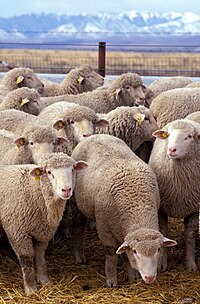
Photo from wikipedia
ABSTRACT Salt cedar (Tamarix spp. L), is found across Texas and the western United States, primarily near riparian areas. Introduced in the 1800s as an ornamental plant, salt cedar escaped… Click to show full abstract
ABSTRACT Salt cedar (Tamarix spp. L), is found across Texas and the western United States, primarily near riparian areas. Introduced in the 1800s as an ornamental plant, salt cedar escaped domestic gardens, invading native rangelands. Mechanical and chemical control options for salt cedar are available, but effective control can be difficult and cost prohibitive. Sheep and goats will readily consume salt cedar after exposure at weaning, and goats readily consume the plant when released on rangelands. Unfortunately, sheep and goats are not a viable option in many areas due to predation or lack of appropriate fencing. The objectives of this study were to determine if cattle would consume salt cedar at a similar level (body weight basis) as sheep and goats and to determine if preconditioning improved acceptance of salt cedar by cattle. Angus-Hereford cross heifers (n = 15), Rambouillet lambs (n = 15), and Boer-Spanish cross kids (n = 15) were placed in individual pens for 21 d and fed salt cedar leaves and tender stems daily. For the first 21 d, eight head from each species were fed a basal diet and salt cedar while 7 head only received the basal diet. The amount of salt cedar in the diet was increased from 5% of the diet to 10% of the diet after 7 d of feeding and fed until d 21. From d 22 to 28 both naïve and familiar animals were fed salt cedar daily. All animals readily increased intake of salt cedar. By d 7, cattle, sheep, and goats consumed the plant, but intake varied daily for cattle and sheep. After the first 7 d, goats consistently ate more (P < 0.05) salt cedar than cattle or sheep. While goats may consume more salt cedar, cattle may be a viable option to reduce salt cedar cover when goats are not a viable option.
Journal Title: Rangeland Ecology and Management
Year Published: 2021
Link to full text (if available)
Share on Social Media: Sign Up to like & get
recommendations!